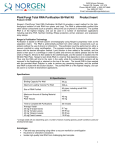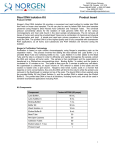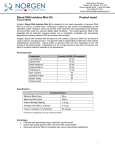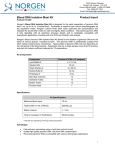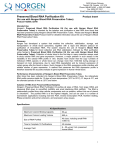Download PCR Purification 96-Well Kit Product Insert
Transcript
3430 Schmon Parkway Thorold, ON, Canada L2V 4Y6 Phone: 866-667-4362 (905) 227-8848 Fax: (905) 227-1061 Email: [email protected] PCR Purification 96-Well Kit Product Insert Product # 24800 Norgen’s PCR Purification 96-Well Kit provides a rapid method for the high-throughput purification of amplified DNA products from PCR mixes. This kit is able to effectively remove PCR by-products including primers, dimers, enzymes, unincorporated nucleotides and mineral oil from the desired PCR product. The purified PCR products are fully compatible with restriction enzyme digestion, ligation into vectors, labeling and sequencing. This kit can also be used as an alternative to organic extraction and ethanol precipitation to clean up various enzymatic reactions. Norgen’s Purification Technology Purification is based on 96-well column chromatography. Norgen’s 96-well plate binds DNA under high salt concentrations and releases the bound DNA under low salt and slightly alkali conditions. The PCR product is first mixed with 5 volumes of the provided Binding Buffer C (please see the flow chart on page 3). It is not necessary to remove the mineral oil from the PCR sample, as it will be removed during the purification process. Next, the sample is loaded onto the 96-Well Plate using either a vacuum manifold or centrifugation. Norgen’s plate binds DNA in a manner that depends on ionic concentrations, thus the DNA will bind to the plate while most of the primers, dimers and other contaminants will flowthrough. The bound DNA is then washed twice using the provided Wash Solution A in order to remove any remaining impurities, and the purified PCR products are eluted with the Elution Buffer B. Specifications Kit Specifications Binding Capacity Per Well 15 g Maximum Loading Volume Per Well 500 L Size of DNA Purified 100 – 15,000 bp Average DNA Recovery > 90% Average Primer Removal > 90% Minimum Elution Volume 50 L Time to Complete 96 Purifications 20 minutes Advantages Fast and easy processing using either a vacuum manifold or centrifugation Purification from all PCR by-products, including primers and dimers Average primer removal is greater than 90% High recovery of PCR products; DNA recovery is greater than 90% of the input DNA Storage Conditions and Product Stability All solutions should be kept tightly sealed and stored at room temperature. These reagents should remain stable for at least 1 year in their unopened containers 1 Kit Components Component Binding Buffer C Wash Solution A Elution Buffer B 96-Well Plate Adhesive Tape 96-Well Collection Plate 96-Well Elution Plate Product Insert Product # 24800 (192 preps) 3 x 30 mL 2 x 38 mL 2 x 15 mL 2 4 2 2 2 . Precautions and Disclaimers This kit is designed for research purposes only. It is not intended for human or diagnostic use. Ensure that a suitable lab coat, disposable gloves and protective goggles are worn when working with chemicals. For more information, please consult the appropriate Material Safety Data Sheets (MSDSs). These are available as convenient PDF files online at www.norgenbiotek.com. The Binding Buffer C contains guanidine hydrochloride, and should be handled with care. Guanidine hydrochloride forms highly reactive compounds when combined with bleach, thus care must be taken to properly dispose of any of this solution. Customer-Supplied Reagents and Equipment For Vacuum Format: o Vacuum manifold with vacuum pump capable of generating a minimum pressure of -650 mbar or -25 in. Hg (such as Whatman UniVac 3 Vacuum to Collect Manifold) o Sealing tape or pads For Centrifuge Format: o Centrifuge with rotor for 96-well plate assembly 95 - 100% ethanol Procedure For Vacuum Manifold: All vacuum steps are performed at room temperature. The correct pressure can be calculated using the conversions: 1 mbar = 100 Pa = 0.0394 in. Hg = 0.75 mm Hg = 0.0145 psi For Centrifugation: All centrifugation steps are performed at room temperature. The correct rpm can be calculated using the formula: RPM = RCF (1.118 x 10-5) (r) where RCF = required gravitational acceleration (relative centrifugal force in units of g); r = radius of the rotor in cm; and RPM = the number of revolutions per minute required to achieve the necessary g-force. 2 Flow Chart Procedure for the Rapid 96-Well Purification of Amplified DNA Products from PCR Mixes Add 5 Volumes of Binding Buffer C to PCR Reaction Bind DNA Wash Twice with Wash Solution A Elute with Elution Buffer B Purified PCR Products 3 Notes prior to use: Ensure that all solutions are at room temperature prior to use, and that no precipitation has occurred. If precipitation is observed, then the solutions should be warmed and mixed gently. Prepare a working concentration of Wash Solution A by adding 90 mL of 96 100% ethanol (to be provided by the user) to the supplied bottles containing concentrated Wash Solution A. This will give a final volume of 128 mL. The labels on the bottles have a box that can be checked to indicate that ethanol has been added. The purification of PCR reactions can be performed using either a vacuum manifold or centrifugation. For purification using vacuum, please follow the procedure outlined in Section A. For purification using centrifugation, please follow the procedure outlined in Section B. A. Purification of PCR Products Using A Vacuum Manifold 1. Sample Preparation a. Add 5 volumes of Binding Buffer C directly to each tube containing a PCR reaction. The maximum volume of PCR reaction that can be processed is 75 L. Mix by pipetting up and down or vortexing. Note: It is not necessary to remove the mineral oil from the PCR sample, as it will be removed during the purification process. 2. Binding DNA to 96-Well Plate a. Assemble the 96-Well Plate and the vacuum manifold according to manufacturer’s recommendations. Note: The provided 96-Well Collection Plate can be used as the collection/waste tray if desired. b. Apply up to 500 L of the PCR reaction mix into each well of the 96-Well Plate. Tape the plate or any unused wells using sealing tape or pads (provided by the user) according to the vacuum manifold manufacturer’s recommendations. Apply vacuum for 2 minutes. c. Turn off vacuum and ventilate the manifold. Discard the flowthrough. Reassemble the 96-Well Plate and the vacuum manifold. Note: Ensure that all of the reaction mix from each well has passed through into the collection/waste tray. If the entire reaction mix volume has not passed, apply vacuum for an additional 2 minutes. 3. Washing Bound DNA a. Apply 400 L of Wash Solution A to each well of the 96-Well Plate. Tape the plate or any unused wells using sealing tape or pads (provided by the user) according to the vacuum manifold manufacturer’s recommendations. Apply vacuum for 2 minutes. Note: Ensure the entire wash solution has passed through into the collection/waste tray by inspecting the 96-Well Plate. If the entire wash volume has not passed, apply vacuum for an additional 2 minutes. 4 b. Turn off vacuum and ventilate the manifold. Discard the flowthrough. c. Reassemble the 96-Well Plate and the vacuum manifold. Repeat steps 3a and 3b to wash column for a second time. d. Pat the bottom of the 96-Well Plate dry. Reassemble the 96-Well Plate and the vacuum manifold. Apply vacuum for an additional 5 minutes in order to completely dry the plate. e. Turn off vacuum and ventilate the manifold. 4. DNA Elution a. Remove the lid from the provided Elution Plate. Replace the collection/waste tray in the vacuum manifold with the Elution Plate. Complete the vacuum manifold assembly with the 96-Well Plate. b. Add 75 L of Elution Buffer B to each well of the plate. c. Apply vacuum for 2 minutes. 5. Storage of DNA Use the provided adhesive tape and/or lid to seal the Elution Plate. The purified DNA samples may be stored at –20°C for a few days. It is recommended that samples be placed at –70°C for long term storage. B. Purification of PCR Products Using Centrifugation 1. Sample Preparation a. Add 5 volumes of Binding Buffer C directly to the tube containing the PCR reaction. The maximum volume of PCR reaction that can be processed is 75 L. Mix by pipetting up and down or vortexing. Note: It is not necessary to remove the mineral oil from the PCR sample, as it will be removed during the purification process. 2. Binding DNA to 96-Well Plate a. Place the 96-Well Plate on top of a provided 96-Well Collection Plate. b. Apply up to 500 L of the PCR reaction mix into each well of the 96-Well Plate. Centrifuge the assembly at maximum speed or 3,000 x g (~3,000 RPM) for 2 minutes. c. Discard the flowthrough. Reassemble the 96-Well Plate and the bottom plate. Note: Ensure that all of the lysate from each well has passed through into the bottom plate. If the entire lysate volume has not passed, centrifuge for an additional 2 minutes. 3. DNA Wash a. Apply 400 L of Wash Solution A to each well of the 96-Well Plate. Centrifuge the assembly at maximum speed or 3,000 x g (~3,000 RPM) for 2 minutes. Note: Ensure the entire wash solution has passed through into the bottom plate by inspecting the 96-Well Plate. If the entire wash volume has not passed, centrifuge for an additional 2 minutes. b. Discard the flowthrough. Reassemble the 96-Well Plate and the bottom plate. c. Repeat steps 3a and 3b to wash column for a second time. 5 d. Pat the bottom of the 96-Well Plate dry. Reassemble the 96-Well Plate and the bottom plate. Centrifuge the assembly at maximum speed or 3,000 x g (~3,000 RPM) for 5 minutes in order to completely dry the plate. 4. DNA Elution a. Remove the lid from the provided Elution Plate. Stack the 96-Well Plate on top of the Elution Plate. b. Add 75 L of Elution Buffer B to each well of the 96-Well Plate. c. Centrifuge the assembly at maximum speed or 3,000 x g (~3,000 RPM) for 2 minutes. 5. Storage of DNA Use the provided adhesive tape and/or lid to seal the Elution Plate. The purified DNA sample may be stored at –20°C for a few days. It is recommended that samples be placed at –70°C for long term storage. Troubleshooting Guide Problem Poor DNA recovery Possible Cause Solution and Explanation Binding of DNA to the plate was inefficient Binding of the DNA is dependent on both pH and salt concentration. Ensure that an appropriate amount of Binding Buffer C was used for the volume of the PCR reaction. The appropriate amount of ethanol was not added to the Wash Concentrate The Wash Solution A has been specifically designed to contain the appropriate amount of components. Ensure that the Wash Solution A was prepared using the correct amount of ethanol. Binding Buffer C was not completely removed in the wash step. Traces of salt left on the plate from the binding step may interfere with the elution of the DNA. Ensure that the column is washed with the Wash Solution A. Proper Elution Buffer was not used The provided Elution Buffer B has been optimized for high elution recoveries. If water or TE buffer is used instead, ensure the pH is around 8. Insufficient vacuum Ensure that a vacuum pressure of at least -650 mbar of 25 in. Hg is developed. Insufficient vacuum will result in low eluate volumes, or eluate volumes varying between wells. 6 Problem DNA does not perform well in downstream applications Clogged Wells in Plate Possible Cause Solution and Explanation Insufficient washing of plate with bound DNA Traces of salt from the binding step may remain in the sample if the column is not properly washed with the Wash Solution A. Ensure that the column is spun for 2 minutes during the washing step. Salt may interfere with downstream applications, and thus must be washed from the column. Eluted DNA contains residual ethanol Ensure that the dry spin is performed after the second DNA wash to remove all traces of ethanol (Step 3d). Insufficient Vacuum Ensure that a vacuum pressure of at least -650 mbar or -25 in. Hg is developed Centrifuge temperature too low Ensure that the centrifuge remains at room temperature throughout the procedure. Temperatures below 15°C may cause precipitates to form that can cause the wells to clog. Related Products PCR Purification Kit DNA Gel Extraction Kit Product # 14400 13100 Technical Support Contact our Technical Support Team between the hours of 8:30 and 5:30 (Eastern Standard Time) at (905) 227-8848 or Toll Free at 1-866-667-4362. Technical support can also be obtained from our website (www.norgenbiotek.com) or through email at [email protected]. 3430 Schmon Parkway, Thorold, ON Canada L2V 4Y6 Phone: (905) 227-8848 Fax: (905) 227-1061 Toll Free in North America: 1-866-667-4362 ©2014 Norgen Biotek Corp. PI24800-6-M14 7








